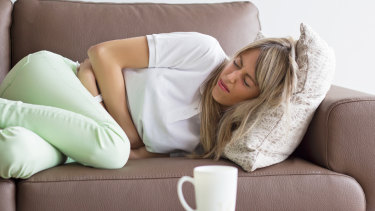
Earlier this year, I decided to get treatment for a couple of varicose veins in my thighs. The aesthetics had never particularly bothered me – I quite like my legs and happily wear shorts – but the veins were getting bothersome. They ached in the heat and throbbed when I exercised and were getting worse with time.
I visited a nurse practitioner who referred me to a phlebologist (specialist in venous disease). He performed an ultrasound and then sat me down for a chat. “Do you have pain in your pelvis?” he asked.
‘Normal’ pain should be manageable with over the counter medications.
I thought for a minute. I’d had pain in my pelvic area since my third child was born. It was so constant and unremarkable I’d never really thought about it. It felt like a drawing down, pulling sensation, as though my uterus was trying to escape my body. When I was ovulating or had my period it was particularly noticeable.
The doctor pointed to the screen. “You have pelvic vein congestion syndrome,” he told me. “Your pelvis is filled with varicose veins. They are what’s causing the veins in your legs. It’s common in women who have had several children. You’re going to need an angiography.”
I was stunned. Sure, I’d noticed the discomfort. But pain is normal for women, particularly around the menstrual cycle. It never occurred to me to do something about it. It had never occurred to me that it was abnormal.
Gabrielle Jackson, author of Pain and Prejudice: A Call to Arms for Women and Their Bodies, has investigated the ways in which our culture treats the pain and suffering of women. Jackson was diagnosed with endometriosis after experiencing crippling symptoms for years, and she believes women’s pain is not taken seriously by the medical profession.
“Women’s pain is normal,” she tells me. “Pain is a woman’s lot.” She explains that, historically, the causes of women’s pain have not been addressed “because women’s pain doesn’t challenge anything … It serves to keep women in at home.”
Pain has always been considered a natural state for women, because menstruation can bring pain, and childbirth is extremely painful. Medical research has traditionally focused on men, Jackson notes in her book, and medications and treatments have largely been trialled on males. In hospitals, women are given less analgesic than men post-surgery, Jackson writes, because women are expected to cope better with extreme pain.
This is bad practice on behalf of medical practitioners, but it has a trickle-down effect on us women. We are conditioned to put up with pain, and to accept our discomfort as appropriate. We tell young girls that periods hurt and encourage them to soldier on. We champion women who give birth without drugs, as though putting up with extreme agony is aspirational and "brave".
No wonder I didn’t question my aching pelvis. No wonder I just accepted it as normal.
I eventually had my pelvic veins treated by a specialist radiographer. He inserted a catheter into my neck which travelled down the carotid artery and embolised the faulty veins on both sides of my pelvis. Within days, my pain was completely gone. It was as though a huge weight had been lifted from my shoulders (or, more specifically, my groin).
Gabrielle Jackson is pushing for medicine to change the way it responds to women by the medical system generally. But on a personal level, we women need to recognise that pain is not normal, and is certainly not good for us.
In terms of period pain, Jackson says, a good rule of thumb is that "normal" pain occurs on the first day or two of bleeding and can be managed with over-the-counter drugs. Extreme pain, or pain that interferes with day to day life, is not normal, requires medical investigation. Chronic pelvic pain is debilitating, and unacceptable. And if an educated, assertive woman like me didn’t recognise that at the age of 50, it seems many of us still have a long way to go.
Source: Read Full Article
